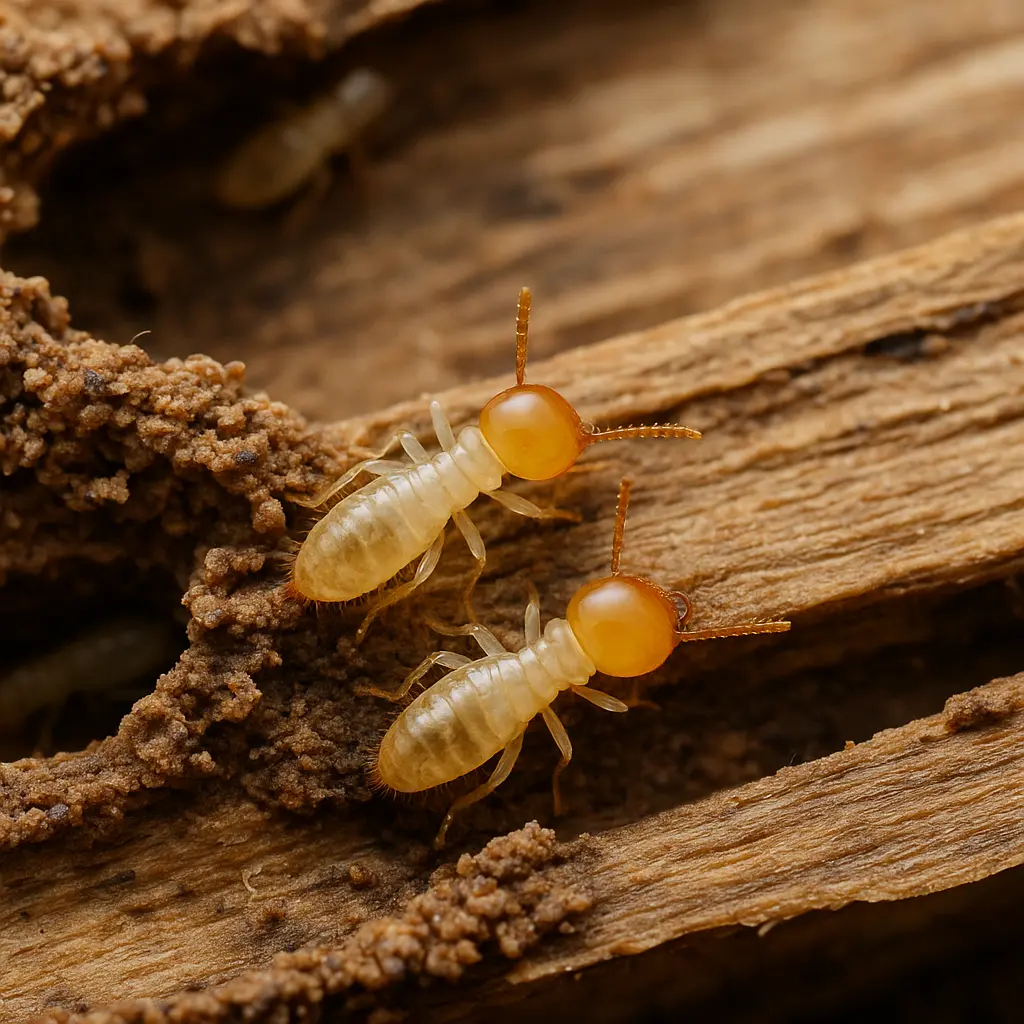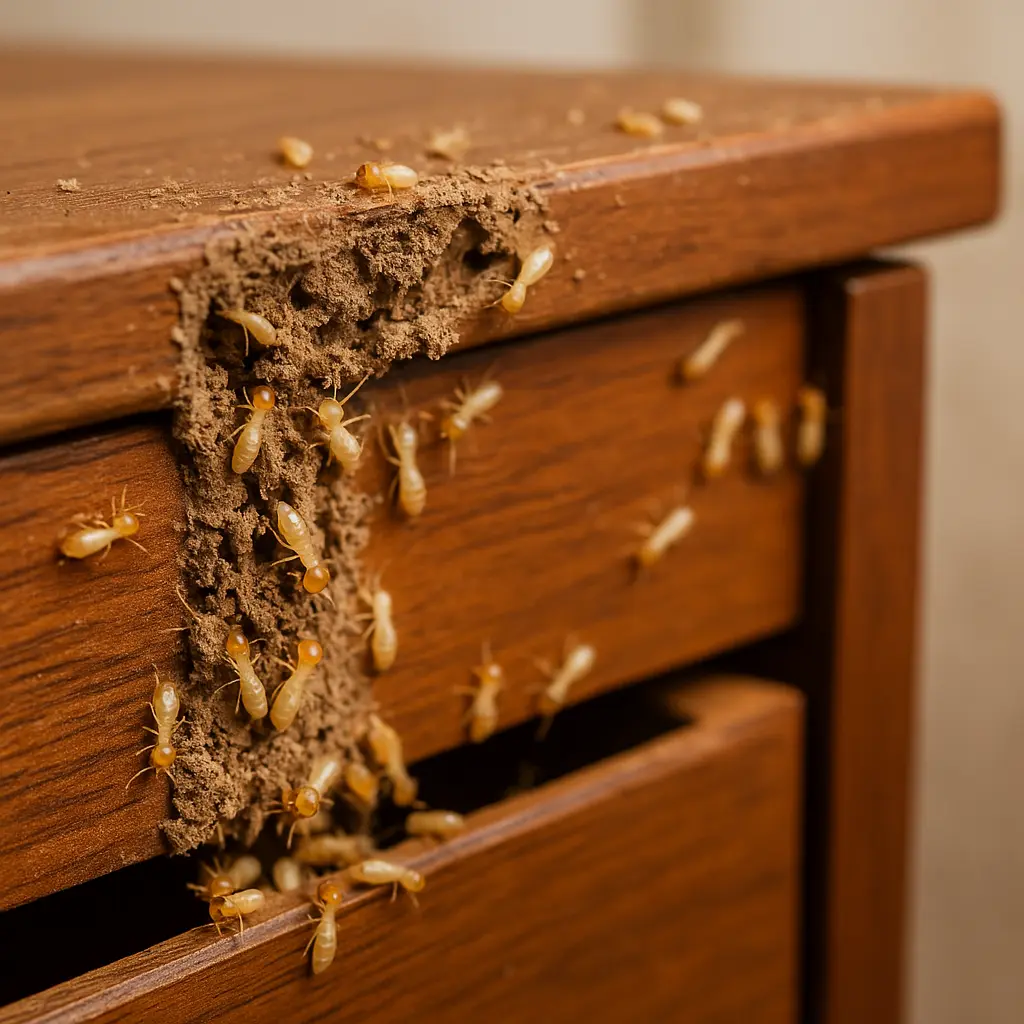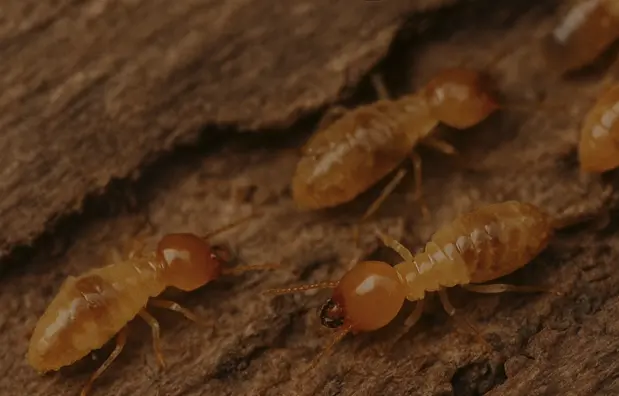"Termites never sleep - a colony can eat through wood 24 hours a day, slowly hollowing beams until a home becomes unsafe without the owners even realizing it."
Common Signs of Termites in Columbus Homes
Termites often hide behind walls, floors, and foundations, but they leave behind subtle clues: hollow-sounding wood when tapped, mud tubes along the foundation, discarded wings near windowsills, or faint clicking noises inside walls. In neighborhoods like Downtown Columbus or North Columbus, homeowners often notice these signs during spring when swarming activity peaks. Don't wait - contact us today.
Real Damage: What Termites Can Do
A single termite colony can consume wood 24 hours a day, gradually weakening beams, flooring, and even roofing structures. In older areas of Columbus with historic wooden homes, infestations have led to costly repairs reaching tens of thousands of dollars. What looks like a small cosmetic issue may actually hide severe structural damage.
How Much Does Termite Control Cost in Columbus?
One of the first questions homeowners ask when they discover signs of termites is simple: "How much is this going to cost me?" The truth is that termite control pricing is not one-size-fits-all. Several key factors influence the final bill, including the size of your home, the construction type, the extent of the infestation, and the treatment method that best suits your situation. Homes in Columbus with basements or crawl spaces often require more extensive work than slab foundations, while properties in humid neighborhoods like North Columbus or Riverside Columbus may see higher costs due to faster colony growth.
On a national level, a basic termite inspection can cost as little as $100-$200. Spot treatments for small, localized colonies average $250-$400. When infestations spread through multiple rooms or structural beams, liquid barrier treatments can range from $800-$1,500. Severe cases that require full-home fumigation are the most expensive, often $2,000-$3,000+. For long-term peace of mind, many homeowners in Columbus choose an annual protection plan, usually between $300-$600 per year.
- Inspection only: $100-$200 - ideal if you suspect early activity or want annual monitoring.
- Spot treatment: $250-$400 - localized drilling or foam injection for small colonies.
- Full barrier treatment: $800-$1,500 - liquid termiticide around the foundation to block future attacks.
- Fumigation: $2,000-$3,000+ - tenting the home and eliminating all hidden colonies, used only in severe infestations.
- Annual protection plan: $300-$600 per year - includes inspections, preventive treatment, and warranty coverage.
Beyond the treatment itself, homeowners should always ask what's included in the quote. Does it cover follow-up inspections? Is there a warranty if termites return within a year? In Columbus, reputable companies typically stand behind their work with at least a 12-month guarantee, and some even offer renewable multi-year plans. Comparing two or three quotes is the best way to balance price with long-term protection, and it ensures you're not paying for unnecessary extras while still safeguarding one of your most valuable assets - your home.
"The average termite colony can contain hundreds of thousands of insects. In just one year, they can consume enough wood to seriously weaken the structure of a house."
What Every Homeowner Should Watch For
Most families don't realize they have termites until the damage is advanced. Over the years, I've learned that the earliest signs of a termite infestation are easy to miss if you don't know what to look for. Here are the four red flags I tell every homeowner to check:
- Hollow-sounding wood - tap beams, floors, or door frames. If they echo like an empty drum, termites may already be inside.
- Mud tubes on walls - pencil-thin tunnels in basements or crawlspaces are highways termites use to travel safely into your home.
- Discarded wings on windowsills - termite swarmers leave piles of wings after they find a new nesting site inside your property.
- Clicking noises in walls - especially at night, that faint ticking is termites chewing through wood nonstop.
If you notice even one of these early termite warning signs, don't ignore it. The damage spreads silently and quickly. Scroll down and schedule a free termite consultation before small signs turn into costly repairs.
"In the United States alone, termites cause over $5 billion in property damage each year - more than fires, floods, and storms combined."
Treatment Options: What Really Works
Liquid Treatments and Barriers
Liquid termiticides are one of the most common and effective termite treatments used across the U.S. Applied into the soil around a home's foundation, they create a protective zone that termites cannot cross. Any termite that comes into contact with the treated soil is eliminated, preventing further damage. In Columbus, this method is especially useful for homes with crawl spaces or basements, where wood-to-soil contact is common and moisture levels are higher. A properly installed barrier can remain effective for several years, offering long-term peace of mind. Don't wait - schedule a free termite consultation today.
The key advantage of liquid treatments is their immediacy: homeowners often notice a reduction in activity within days. On the downside, application may require trenching around the home or drilling through patios and concrete slabs, which adds to the labor. Still, for many residents in neighborhoods like North Columbus or Riverside Columbus, it's considered the most reliable first line of defense.
Bait Stations
Bait systems take a different approach. Instead of blocking termites out, they attract termites in. Small monitoring stations are placed strategically in the soil around the property. When termites discover the bait, they feed on it and carry it back to the colony, gradually spreading a slow-acting insecticide that wipes out the entire nest. This makes baiting an excellent long-term solution that targets the source of the problem.
In Columbus, bait stations are often recommended for properties close to wooded areas, parks, or rivers, where termite colonies thrive in natural soil environments. They are lower in toxicity compared to liquid chemicals, making them a good choice for families with children or pets. The main drawback is speed-baiting systems can take weeks or even months to fully eliminate a colony, so they require regular monitoring by professionals.
"In Columbus, homeowners in older wooden neighborhoods should schedule inspections every 6-12 months for true peace of mind."

Fumigation (Severe Cases)
For severe or widespread infestations, fumigation may be the only effective solution. This process involves covering the entire home with a sealed tent and releasing a fumigant gas that penetrates deep into walls, floors, and hidden voids. It kills termites at every life stage, ensuring complete eradication.
While highly effective, fumigation is also the most disruptive and costly option, often ranging from $2,000-$3,000+. Families must vacate the home for several days, and there is preparation required such as bagging food and medicines. In older parts of Columbus where homes are built primarily with wood framing, fumigation is sometimes the only way to stop a colony that has already spread throughout multiple structures. Homeowners usually turn to this method as a last resort when other treatments are no longer sufficient.
"Even a mud tube the width of a pencil along your foundation can be a warning sign that thousands of termites are already inside your home."
Prevention Tips for Homeowners
When it comes to termites, prevention is always more affordable and effective than repairs. Every year, homeowners across the U.S. spend billions of dollars fixing termite damage, and most of it could have been avoided with simple preventive steps. In Columbus, where warm weather and seasonal humidity create perfect conditions for termite colonies, early action makes the difference between peace of mind and costly surprises. Below are the most important prevention strategies that experts recommend. For tailored advice, contact our local experts.
"Keep firewood at least 20 feet away from your foundation - stacked wood is like an open invitation for termites."
- Store firewood and lumber far from the home: Woodpiles stacked directly on the ground near your foundation are one of the leading causes of termite infestations. Always keep wood at least 20 feet away from your house and raised off the soil. In neighborhoods like North Columbus or East Columbus, where homes often back onto wooded areas, this step is especially critical.
- Control excess moisture: Termites thrive in damp environments. Fix leaking pipes, dripping faucets, and clogged gutters immediately. Poor drainage around the home encourages standing water near the foundation, which attracts termites year-round. Adding a French drain or sump pump in flood-prone basements can prevent conditions that colonies love.
- Seal cracks and gaps in the structure: Termites only need a space as thin as a credit card to enter your home. Seal foundation cracks, gaps around utility pipes, and spaces around vents to reduce entry points. Professional sealing can make a big difference in high-risk areas like Downtown Columbus, where older buildings often have more access points.
- Limit wood-to-soil contact: Porch steps, deck posts, and wooden fences that sit directly on the soil act as a "highway" for termites into your home. Use concrete bases or metal supports to separate wood from the ground whenever possible.
- Choose landscaping carefully: Mulch beds may look beautiful, but they hold moisture and provide food for termites. If you use mulch, keep it at least 12-18 inches away from your foundation. In humid neighborhoods of Columbus, replacing mulch with gravel or stone can lower risk dramatically.
- Schedule annual inspections: Even the most careful homeowner can miss early signs of termites. A licensed pest control professional can detect hidden activity before it becomes visible. In Columbus, most experts recommend yearly inspections, and in high-risk zones, every six months is even better.
- Maintain proper ventilation: Crawl spaces and attics should be kept dry and well-ventilated. Installing vapor barriers and dehumidifiers reduces the damp conditions termites look for. Homes near rivers or coastal areas of Columbus benefit most from this approach.
Combining these preventive measures creates a strong defense against infestations. Remember, termites don't just disappear on their own - once they find a food source, they continue eating 24/7. A proactive plan that includes moisture control, structural maintenance, smart landscaping, and professional inspections gives homeowners in Columbus the best chance of staying termite-free. Not only does this save thousands of dollars in potential repairs, but it also protects the long-term value of your property.
Homeowners often ask: "Do termites come back even after treatment?" The answer is yes - if preventive steps are ignored. That's why ongoing care is just as important as the initial treatment. By investing in prevention today, you avoid the stress, expense, and disruption that termite damage can bring tomorrow.
"In humid cities like Columbus, termites spread faster because moisture makes wooden homes the perfect target for colonies."
My Advice to Every Homeowner
If there's one lesson every homeowner in Columbus should take seriously, it's that early termite inspections save money, stress, and even the structural safety of your house. Termites are called the "silent destroyers" because by the time obvious signs appear, the damage is already extensive. Small clues - a clicking sound in the walls, a mud tube along the foundation, or hollow wood when you tap a beam - may seem minor, but they are red flags that a colony could already be active inside your home.
Too many homeowners delay, hoping the problem will go away on its own. It never does. A certified pest control technician can confirm or rule out termite activity in minutes, and the cost of an inspection is tiny compared to the thousands of dollars in repairs needed after months of undetected damage. That's why I always recommend annual termite checks as the cheapest and most effective form of insurance. In humid neighborhoods of Columbus, inspections every six months can make all the difference.
The sooner termites are detected, the easier, faster, and less costly the treatment will be. Whether it's a simple spot treatment or a full protective barrier, acting early means you stay ahead of the problem instead of letting the termites stay ahead of you.

Take Action Before It's Too Late
Termites don't wait - and neither should you. Every day a colony is left untreated, it continues eating through wood 24 hours a day. If you live in Columbus and suspect even the smallest sign of termite activity, the smartest step you can take is to schedule a professional inspection right away.
Early detection can save you thousands in repair costs, protect the long-term value of your property, and give you peace of mind that your home is safe. Don't wait until damage becomes visible - by then, it's often too late. Take action today and make sure termites never get the chance to make your house their next meal. Contact us now for a free termite inspection.
"The cheapest way to fight termites is prevention: annual inspections cost a fraction of repairing hidden structural damage."
